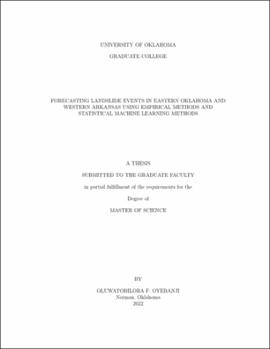| dc.contributor.advisor | Hougen, Dean | |
| dc.contributor.author | Oyebanji, Oluwatobiloba | |
| dc.date.accessioned | 2022-09-22T19:55:23Z | |
| dc.date.available | 2022-09-22T19:55:23Z | |
| dc.date.issued | 2022-12 | |
| dc.identifier.uri | https://hdl.handle.net/11244/336527 | |
| dc.description.abstract | Understanding the trend of landslide occurrence in eastern Oklahoma and western Arkansas is crucial to the human and social development of the region. Studies suggest rainfall is one of the major landslide triggering mechanisms in the area. However, the association of landslides and rainfall is yet to be fully understood. Here, we analyze rainfall patterns at numerous landslide locations to better characterize the major rainfall conditions that can trigger landslides in the study area. The rainfall-landslide association was determined based on empirical threshold analysis and statistical machine learning approaches. The empirical threshold curve implemented aligns with similar curves developed for regions around the globe.
The developed empirical threshold captures 95 % of the landslide events above the threshold but fails to discriminate over half of non-landslide rainfall events from the landslide rainfall events. The empirical threshold trend also indicates that a small rainfall intensity can trigger landslides in the region.
Five machine learning approaches including K-nearest neighbor, logistic regression, random forest, gradient boost classifier, and voting ensemble classifier were used to determine important rainfall conditions that can trigger landslides. Rainfall features such as rainfall intensity, cumulative rainfall and antecedent rainfall conditions were integrated as input features for the models.
The ensemble classifier model correctly predicted all landslide events in the test dataset with a recall of 100%. The two–week antecedent rainfall data is ranked as the most important feature for forecasting landslide occurrence. Results from this study can be used in developing a landslide early warning an forecasting system as well as in making decisions for hillslope and natural resources management. | en_US |
| dc.language | en_US | en_US |
| dc.subject | Landslides | en_US |
| dc.subject | Machine Learning | en_US |
| dc.subject | Rainfall | en_US |
| dc.subject | Oklahoma | en_US |
| dc.title | Forecasting landslide events in eastern Oklahoma and western Arkansas using empirical methods and statistical machine learning methods | en_US |
| dc.contributor.committeeMember | Regmi, Netra | |
| dc.contributor.committeeMember | Diochnos, Dimitrios | |
| dc.date.manuscript | 2022-09 | |
| dc.thesis.degree | Master of Science | en_US |
| ou.group | Gallogly College of Engineering | en_US |
| shareok.orcid | 0000-0001-8982-9955 | en_US |
